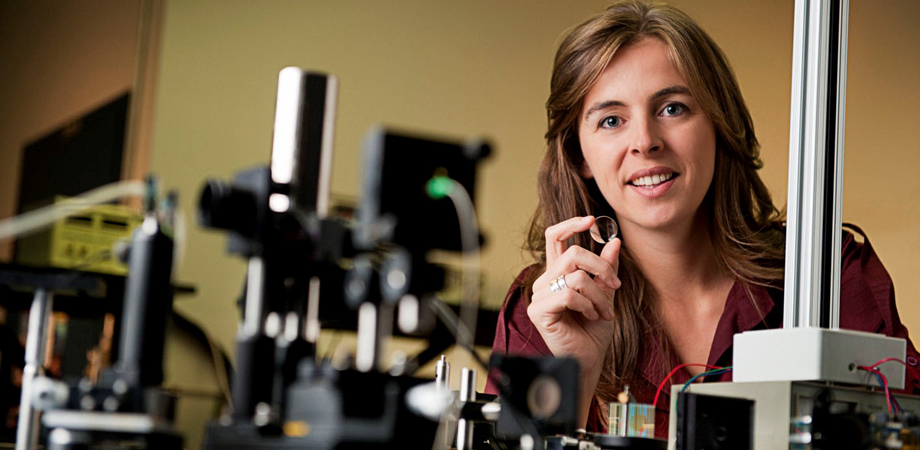Novel ‘few mode’ innovation reboots and expands OCT

Professor Caroline Boudoux is casting new light from her photonic lantern for optical coherence tomography. At Polytechnique Montreal, Caroline Boudoux’s lab has developed a new version of a popular medical imaging technology for optical coherence tomography, or OCT, based on an optical fiber device called a photonic lantern.
It will have a variety of medical and other applications, which Boudoux spelled out in detail at the BiOS Hot Topics in her presentation at SPIE Photonics West in January.
She works with a particular type of hardware called modally specific photonic lanterns, which act as (de-)multiplexers of spatial modes in fiber optics.
Boudoux said her team, in collaboration with colleague Nicolas Godbout, has developed a new way to model and manufacture the lantern “with better specifications and using a technique compatible with largescale manufacturing, to allow rapid translation outside the lab.”
What makes the new version particularly useful is the lantern’s application as an imaging system for OCT. “The lantern lets us create images with more photons, and that makes possible better contrast,” Boudoux said.
The lantern makes use of optical fiber’s single mode and multimode characteristics. “And everything in between,” Boudoux said. The lantern separates multimode signals into individual modes with exquisite modal separation, and very little insertion loss.
In what’s called the “few-mode” (or FM) OCT, the lantern collects light scattered from an object onto a “few-mode” fiber and generates output into several single mode fibers.
“The lantern separates the energy collected by the few-mode fiber into individual single mode fiber signals,” Boudoux said, “each fiber carries the energy of a distinct mode of the few-mode fiber.”
To create OCT images, each single-mode fiber output is coupled to a fiber-based interferometer. Several OCT images are created in parallel — one for each mode collected by the few-mode fiber.
Each mode carries particular information about the microstructure of an organ.
At Photonics West, Boudoux and her team showed preliminary data supporting this enhanced contrast.
Her team also showed the measurement of flow velocities for particles moving in the 3D field of view.
Using several modes of the lantern allows measuring flows in the axial and transverse directions with high accuracy and speed. This shows great potential for OCT angiography, Boudoux said, and also for LIDAR applications.
Boudoux said the photonic lanterns will be manufactured by Castor Optics inc., a spinoff she co-founded in 2013 with Nicolas Godbout, Normand Brais and Alex Cable. Castor manufactures optical-fiber components designed by her and Godbout’s teams including custom and double-clad fiber couplers.
As for Castor’s other couplers, the lanterns will be marketed by Thorlabs Inc. through a strategic partnership.
At the Photonics West trade show, Castor demonstrated photonic lanterns, double-clad fiber couplers and multimode circulators at several wavelength bands, for applications in imaging and remote sensing.
Boudoux is a professor of engineering physics at Polytechnique Montréal. She earned her PhD from the Harvard-MIT Division of Health Sciences and Technology in 2007, and did a post-doctoral fellowship in nonlinear microscopy at École Polytechnique Paris. Her areas of research have included biomedical imaging, optical coherence tomography, confocal and nonlinear microscopy, and endoscopic imaging.
In 2016, she published Fundamentals of Biomedical Optics, a textbook for engineers and physicists interested in designing new imaging instruments based on optics. She is currently putting the final touch to It Goes Without Saying: A Field Guide for PhD Students in Engineering, to be published by MIT Press in the coming year. In her lab, Boudoux says, “we build our own OCT systems, and our own sources. But we also rely heavily on the MEMS-VCSEL swept-wavelength laser source from Thorlabs.”
Based in New Jersey, Thorlabs markets various components and systems in the OCT field.
Boudoux and her team use such components to demonstrate the capabilities of FM-OCT and flow-velocity measurements for transfer to various integrators in the fields of microscopy and remote sensing.
She added, “These are very exciting times for the Boudoux crew as both novel hardware and capabilities are being developed rapidly, with rapid transfer to the industry and a high potential for impact.”
Ford Burkhart is a science and technology writer based in the US. A version of this article appeared in the 2023 Photonics West Show Daily.
| Enjoy this article? Get similar news in your inbox |
|



